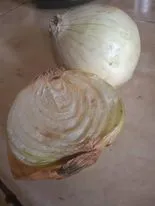Creditos por esta informacion a:/ Credit by this information to:[https://www.cuerpomente.com/guia-alimentos/cebolla]

Photography 1. Taked on table of my mom.
This is one of the healthiest and most nutritious plants, its medicinal powers are many, due to its vitamin content it is a great revitalizer of the human organism, below I share with you some of the information that was obtained in reading books and internet pages , which can be consulted by you, dear friends, since a lot of information is obtained from this product of nature.
La cebolla procede de Asia y era considerada casi un talismán por los egipcios, que le atribuían el alivio de numerosas enfermedades. También era sumamente apreciada por griegos y romanos. El gran médico Hipócrates la prescribía como diurético, para curar heridas y tratar neumonías. La medicina tradicional china la recomendaba sobre todo para enfermedades respiratorias.
The onion comes from Asia and was considered almost a talisman by the Egyptians, who attributed it to the relief of many diseases. It was also highly appreciated by the Greeks and Romans. The great physician Hippocrates prescribed it as a diuretic, to heal wounds and treat pneumonia. Traditional Chinese medicine recommended it above all for respiratory diseases.
En cuanto a sus vitaminas y minerales, procura buenas dosis de vitamina C (9 mg/100 g), potasio (300 mg), calcio (32 mg) y fósforo (44 mg), así como un alto porcentaje del oligoelemento cromo y pequeñas cantidades de azufre, bromo, cobalto, cobre, magnesio, silicio y cinc.
Regarding its vitamins and minerals, have good doses of vitamin C (9 mg / 100 g), potassium (300 mg), calcium (32 mg) and phosphorus (44 mg), as well as a high percentage of the trace element chromium and small amounts of sulfur, bromine, cobalt, copper, magnesium, silicon and zinc.
También es muy rica la cebolla en fitoquímicos, entre los que destaca el flavonoide quercitina. Este antioxidante, más potente que la vitamina E, tiene propiedades antiinflamatorias, antialérgicas y protectoras frente al cáncer, especialmente de mama, colon y próstata; además, puede ayudar a reducir los síntomas de fatiga, ansiedad y depresión.
The onion is also very rich in phytochemicals, among which the flavonoid quercithin stands out. This antioxidant, more powerful than vitamin E, has anti-inflammatory, antiallergic and protective properties against cancer, especially of the breast, colon and prostate; Additionally, it can help reduce symptoms of fatigue, anxiety, and depression.
Es interesante su contenido en glucoquinina, una sustancia considerada la insulina vegetal, pues ayuda a combatir la diabetes.Además alberga compuestos azufrados con efecto depurativo y aceite esencial con propiedades bactericidas y fungicidas. La fama de la cebolla como alimento depurativo es bien merecida, pero sus propiedades y beneficios para la salud van mucho más allá.
Its glucokinin content is interesting, a substance considered vegetable insulin, as it helps fight diabetes, it also contains sulfur compounds with a cleansing effect and essential oil with bactericidal and fungicidal properties. The reputation of the onion as a cleansing food is well deserved, but its properties and health benefits go much further.

Tomada en la mesa de mi mamá
Photography 2.Taked on the table of my mom
Es rica en fructo-oligosacáridos, prebióticos que estimulan el crecimiento de bifidobacterias en el intestino e inhiben el desarrollo de bacterias patógenas. Este equilibrio en la flora intestinal reduce el riesgo de cáncer de colon. It is a heart-healthy vegetable. Due to its sulfur components, onion consumption prior to platelet aggregation and thrombus formation, as well as high cholesterol and triglycerides. It is diuretic. Due to its richness in potassium and low sodium, the resulting onion is diuretic and helps in cases of edema, hypertension and heavy legs. It is rich in fructo-oligosaccharides, prebiotics that stimulate the growth of bifidobacteria in the intestine and inhibit the development of pathogenic bacteria. This balance in the intestinal flora reduces the risk of colon cancer. La cebolla contribuye a la salud digestiva. Previene la fermentación intestinal, la presencia de parásitos y hongos, y el estreñimiento. Alivia las digestiones pesadas y la flatulencia con hipoclorhidria, pero hay que ser cauto si se suele sufrir acidez. Es antioxidante. Otro de los beneficios de la cebolla es que contiene quercitina, un flavonoide de propiedades antiinflamatorias, antialérgicas y protectoras frente al cáncer. Es antidiabética. Gracias a su riqueza en cromo, que forma parte del llamado FTG (Factor de Tolerancia a la Glucosa), y también a la glucoquinina, que estimula el páncreas, ayuda a reducir el nivel de azúcar en la sangre en las personas diabéticas. Es anticancerígena. Numerosos estudios demuestran que su ingesta habitual previene el cáncer, siendo este uno de los beneficios más reseñables de la cebolla para la salud. Quienes la comen regularmente presentan, por poner un ejemplo, un riesgo un 40% menor de desarrollar cáncer de estómago.* Onion contributes to digestive health *. It prevents intestinal fermentation, the presence of parasites and fungi and constipation. Relieve heavy digestions and flatulence with hypochlorhydria, but be careful if you tend to suffer from heartburn. It is antidiabetic. Thanks to its richness in chromium, which is part of the so-called GTF (Glucose Tolerance Factor), and also to glucokinin, which stimulates the pancreas, it helps to reduce the level of sugar in the blood in diabetic people. It is anticancer. Numerous studies show that its regular intake prevents cancer, this being one of the most notable benefits of onion for health. Those who consume it regularly have, for example, a 40% lower risk of developing stomach cancer. La cebolla tiene propiedades antisépticas. Las propiedades antisépticas y mucolíticas de los componentes azufrados, junto con la acción antiinflamatoria de la quercitina, la hacen eficaz frente a problemas respiratorios como resfriados, bronquitis y asma. También es un conocido remedio popular frente a la tos dejar una cebolla cortada por la mitad en la mesilla de noche. The onion has antiseptic properties. The antiseptic and mucolytic properties of the sulfur components, together with the anti-inflammatory action of quercetin, make it effective against respiratory problems such as colds, bronchitis and asthma. It is also a popular cough remedy to leave an onion cut in half on the bedside table. [https://www.cuerpomente.com/guia-alimentos/cebolla] Remedios preparados con cebolla. Para gripe o resfriado: se dejan macerar 4 cebollas durante 24 horas en un litro de agua tibia. Se toma una taza entre las comidas y antes de acostarse. Para la diabetes: la preparación anterior, a razón de una taza al día por la mañana en ayunas, ayuda a reducir el nivel de glucemia. Piernas hinchadas: se ralla finamente 150 gramos de cebolla y se pone en una botella con su mismo peso en alcohol de 90º. Se deja macerar 10 días removiendo cada día. Luego se cuela exprimiendo bien. Se toman 3 o 4 cucharaditas de esta tintura al día, mejor con un poco de agua. Se puede hacer una cura durante un mes, dos o tres veces al año. Remedies prepared with onion. For flu or cold: 4 onions are marinated for 24 hours in a liter of warm water. Have a cup between meals and before bedtime. For diabetes: the previous preparation, a ratio of one cup a day in the morning on an empty stomach, helps to reduce the blood glucose level. Swollen legs: 150 grams of onion is finely grated and put in a bottle with the same weight in 90º alcohol. It is left to marinate for 10 days, stirring every day. Then it is strained by squeezing well. Take 3 or 4 teaspoons of this tincture a day, better with a little water. A cure can be done for a month, two or three times a year. For tooth pain and headache take two tablespoons of onion juice. For earache: drops of roasted onion juice in the affected ear. For nosebleeds: place half a freshly cut onion on the nape of the patient, to stop the blood from the nose and breathe its smell. Hive friends are much appreciated
Es diurética. Por su riqueza en potasio y escaso sodio, la cebolla resulta diurética y ayuda en casos de edemas, hipertensión y piernas pesadas.La cebolla es un alimento prebiótico.
It is an antioxidant. Another benefit of onion is that it contains quercetin, a flavonoid with anti-inflammatory, anti-allergic and protective properties against cancer.

*Para el dolor de dientes y dolor de Cabeza tomardos cucharadas de jugo de cebolla.
*Para dolor de oido::gotas de jugo de cebolla asada en el oido afectado.
*Para hemorragias nasales: colocar la mitad de un cebolla recien cortada sobre la nuca del paciente,para detenar la sangra de la nariz y repirar su olor.
